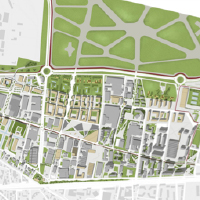Decision-making tools for urban regeneration processes: from Stakeholders Analysis to Stated Preference Methods
Abstract
Urban regeneration operations are connected to the creation of a multiplicity of benefits, both economic and extra-economic, that range from the increase in the environmental quality to the amelioration of the urban image, from the valorization of the cultural heritage to the creation of economic development processes. The articles aims at proposing an integrated evaluation approach for addressing decision problems in the context of urban regeneration operations. Starting from the real case of the regeneration programme of the city of Collegno (Italy), the contribution proposes an original evaluation model based on the combined use of Stakeholders Analysis and Stated Preference Methods. The results of the research shows the people’s perception about the social value of urban regeneration programme and their Willingness To Pay for specific transformation operations.
Downloads
References
Altunkasa M. F., Berberoğlu, S., Uslu, C., Duymuş, H. (2017). The Effectiveness of Urban Green Spaces and Socio-Cultural Facilities. Tema. Journal of Land Use, Mobility and Environment, 10(1), 41-56. doi:http://dx.doi.org/10.6092/1970-9870/4087.
Berta, M., Bottero, M. & Ferretti, V. (2016). A mixed methods approach for the integration of urban design and economic evaluation: Industrial heritage and urban regeneration in China. Environment and Planning B: Planning and Design, 1-25. doi: http//dx.doi.org/10.1177/0265813516669139.
Bottero, M. (2014). The economic value of landscape: an application for a rural area in Northern Italy. In C. Rega (Ed.), Landscape Planning and Rural Development (89-104) Berlin: Springer. doi:http://dx.doi.org/ 10.1007/978-3-319-05759-0_5.
Bottero, M. (2015). A multi-methodological approach for assessing sustainability of urban projects. Management of Environmental Quality: an International Journal, 26(1), 138-154. doi:http://dx.doi.org/10.1108/MEQ-06-2014-0088.
Bottero, M. & Mondini, G. (2016). Evaluation of social benefits of urban regeneration: a stated preferences approach. Proceedings of the 9th International Conference on Innovation in Urban and Regional Planning. Torino (IT), 14-15 September 2016, 447-452. ISBN 978-88-9052-964-1.
Bourne, L. & Walke D. (2008).Project relationship management and the Stakeholder Circle™. International Journal of Managing Projects in Business, 1 (1), 125 – 130. doi: https://doi.org/10.1108/17538370810846450.
Boxall, P., Adamowicz, W., Swait, J., Williams M. & Louviere, J. (1996). A comparison of stated preference methods for environmental valuation. Ecological Economics, 18 (3), 243–253. doi: http://dx.doi.org/10.1016/0921-8009(96)00039-0.
Carson, R.T. (2000). Contingent Valuation: A User’s Guide. Environmental Science & Technology, 8, 1413-1418. https://doi.org/10.1021/es990728j.
Cerreta, M., & De Toro, P. (2010). Integrated Spatial Assessment for a Creative Decisionmaking Process: a Combined Methodological Approach to Strategic Environmental Assessment. International Journal of Sustainable Development, 13(1/2), 17–30. doi: https://doi.org/10.1504/IJSD.2010.035096.
Del Saz-Salazar, S. & Garcia-Menendez, L. (2003). The Nonmarket Benefits of Redeveloping Dockland Areas for Recreational Purposes: The Case of Castellón, Spain. Environment and Planning A, 35(12), 2115 – 2129. doi:https://doi.org/10.1068/a364.
Dente, B. (2014). Understanding Policy Decisions. Springer: New York. doi:https://doi.org/10.1007/978-3-319-02520-9.
Hanley, N. & Spash, C.L. (1993). Cost-Benefit Analysis and the Environment. Aldershot: Edward Elgar Publishing Limited. doi:http://dx.doi.org/10.1787/5jrp6w76tstg-en
Knoke, D. & Yang, S (2008). Social Network Analysis. London: Sage. doi:http://dx.doi.org/10.4135/9781412985864.
Louviere, J.J., Henser, D.A.& Swaitt, J.D. (2000). Stated Choice Methods. Analysis and Application. Cambridge: Cambridge University Press. doi:https://doi.org/10.1017/CBO9780511753831.008.
Maltese, I., Mariotti, S., Oppio, A. & Boscacci, F. (2016). Itinerari storico-culturali per lo sviluppo del territorio: la stima dei benefici attraverso un’analisi contingente. Proceedings of the XXXVII AISRE Conference, Ancona, 1-21. Available at: http://hdl.handle.net/11311/1013956.
Mazzanti, M. (2002). Cultural heritage as multi-dimensional, multi-value and multi-attribute economic good: toward a new framework for economic analysis and valuation. Journal of Socio-Economics, 31, 529–558. doi: https://doi.org/10.6092/issn.2036-5195/3208.
Mitchell R.C. &. Carson, R.I. (1989). Using surveys to value public good: the contingent valuation method. Washington D.C.: Resource for the Future. Available at: http://www.jstor.org/stable/24883508.
Olander, S. & Landin, A. (2005). Evaluation of stakeholder influence in the implementation of construction projects. International Journal of Project Management, 23, 321–328. doi:https://doi.org/10.1016/j.ijproman.2005.02.002.
Pearce, D.W., Turner R.K. (1990). Economics of Natural Resources and the Environment. Baltimore: Johns Hopkins University Press. doi:https://doi.org/10.2307/1242904.
Pearce, D.W., Ozdemiroglu, E. et al. (2002). Economic Valuation with Stated Preference Techniques. Summary Guide. London: Department for Transport, Local Government and the Regions. ISBN: 9781843768524.
Roberts P. (2000). Evolution, Definition and Purpose of Urban regeneration. In P. Roberts & H. Sykes (Eds.) Urban Regeneration: A Handbook. London: Sage. doi:http://dx.doi.org/10.4135/9781446219980.
Stellin G. & Rosato, P. (1998). La valutazione economica dei beni ambientali. Torino: CittaStudi Edizioni. ISBN: 882510121X.
Strazzera, E., Cherchi, E., & Ferrini S. (2010). Assessment of Regeneration Projects in Urban Areas of Environmental Interest: A Stated Choice Approach to Estimate Use and Quasi-Option Values. Environment and Planning A, 42(12), 452 – 468. doi: http://dx.doi.org/10.1068/a4213.
Tyler, P., Warnock, C., Provins A. & Lanz, B. (2013). Valuing the benefits of urban regeneration. Urban studies, 50, 169-190. doi: http://dx.doi.org/10.1177/0042098012452321
World Bank (1998). Economic Analysis and Environmental Assessment. Environmental Assessment Sourcebook Update, 23. doi:http://dx.doi.org/10.1596/0-8213-1843-8.
Yang, R.J. (2014). An investigation of stakeholder analysis in urban development projects: Empirical or rationalistic perspectives. International Journal of Project Management, 32(5), 838-849. doi: http://dx.doi.org/10.1016/j.ijproman.2013.10.011.
Ying E.H.K. & Chan, E.H.W. (2015). Evaluation of the social value and willgness to pay for conserving built heritage in Hong Kong, Facilities, 33, 76-98. doi:http://dx.doi.org/10.1108/F-02-2013-0017.

Copyright (c) 2017 Tema. Journal of Land Use, Mobility and Environment

This work is licensed under a Creative Commons Attribution 4.0 International License.
Authors who publish in this journal agree to the following:
1. Authors retain the rights to their work and give in to the journal the right of first publication of the work simultaneously licensed under a Creative Commons License - Attribution that allows others to share the work indicating the authorship and the initial publication in this journal.
2. Authors can adhere to other agreements of non-exclusive license for the distribution of the published version of the work (ex. To deposit it in an institutional repository or to publish it in a monography), provided to indicate that the document was first published in this journal.
3. Authors can distribute their work online (ex. In institutional repositories or in their website) prior to and during the submission process, as it can lead to productive exchanges and it can increase the quotations of the published work (See The Effect of Open Access)
